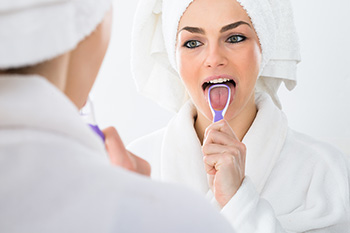 Bacteria can accumulate on pretty much any surface of your mouth. They prefer to attach themselves to rough surfaces, so the teeth and gum line are particularly prone to plaque accumulation. Did you know that the surface of your tongue is rough, containing thousands of papilla, also known as taste buds, that cause the top surface of your tongue to contain many crevices, a perfect spot for bacteria to hide? If you don’t brush or clean your tongue, you may not even realize how much plaque accumulation it can be prone to. Once you start cleaning your tongue, you may never go back!
Bacteria can accumulate on pretty much any surface of your mouth. They prefer to attach themselves to rough surfaces, so the teeth and gum line are particularly prone to plaque accumulation. Did you know that the surface of your tongue is rough, containing thousands of papilla, also known as taste buds, that cause the top surface of your tongue to contain many crevices, a perfect spot for bacteria to hide? If you don’t brush or clean your tongue, you may not even realize how much plaque accumulation it can be prone to. Once you start cleaning your tongue, you may never go back!
Signs and symptoms of plaque accumulation on the tongue
- White/beige or yellow coating on the top surface of the tongue
- Altered or reduced sense of taste
- Bad breath, called halitosis
- Bad taste in the mouth
How to clean your tongue
You can use your toothbrush or a handy tool called a tongue scraper specifically designed to clean your tongue. These devices usually have bristles that you can use to scrape from the back to the front of the tongue. You will need to repeat this brush motion more than once and rinse the device in between if required. You will be surprised to see how much plaque accumulation you can get off your tongue, even after one day. You will notice immediately after cleaning that the surface coating will be removed, and your tongue will appear pinker in colour. It is recommended to clean your tongue twice a day, each time you brush.
Did you know that rinsing won’t work to clean your tongue effectively? Although mouth rinses are an excellent way to reduce overall oral bacteria, they will only kill the outer layer of bacteria on the tongue, just like the teeth. That means that only brushing/scraping can disrupt and remove the bacteria colonies after they have formed.
If you have any questions about tongue cleaning or would like to discuss which tool will work best for you, please get in touch with us to schedule an appointment.
